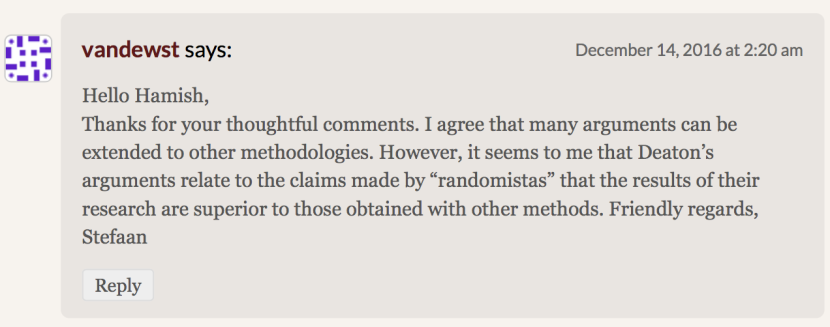Misunderstandings and misrepresentations of randomised trials and what is claimed for them
I recently read this blog post, which presents and expands on Angus Deaton and Nancy Cartwright’s recent thoughts about RCTs. It is worth a read because, in my view, it is an excellent case study of the misunderstanding and misrepresentation of the the claims made in favour of RCTs. Deaton and Cartwright must take the lion’s share of the blame here, not the author of the post, though he does add to the commentary some startling assertions. Here are two of many:
RCTs do not have external validity.
and
A key argument in favour of randomization is the ability to blind both those receiving the treatment and those administering it.
Both assertions are just plain wrong. Although the author does demonstrate a more nuanced understanding of the value of randomised trials elsewhere:
The results of RCTs must be integrated with other knowledge, including the
practical wisdom of policy makers if they are to be usable outside the context in which they were constructed.
In a response to a comment I made on his post suggesting that Deaton’s and Cartwright’s arguments unfairly target randomised trials, when the criticisms they make are equally applicable to all kinds of intervention research, the author responded thusly:
I think that this argument fails to acknowledge the single defining feature of a randomised trial and also misrepresents what is claimed for them by people who the author has called ‘randomistas’. Moreover, what Deaton considers to be the position of so called ‘randomistas’, specifically, is irrelevant (or at best thoughtless) when his criticisms are not actually of randomised trials but of all types of research.
My response to the above comment is reproduced below.
You may be correct about how Deaton views ‘randomistas’, but if so, he really needs give examples of people claiming that the results of RCTs are superior to results of obtained using other methods. I am a proud ‘randomista’ and I work with a lot of people who might be classified as such, and the idea that people like me say that the results of RCTs are always superior to alternative methods is just not a familiar one. In fact when reading reports of RCTs it is common to find loads of caveats about the findings.
People who understand what RCTs are and what they are not know that the only unique feature of the design is that they generate comparison groups by randomly allocating cases to conditions. That’s it.
I don’t think it is controversial for ‘randomistas’ to argue that this is the best way of generating comparison groups that differ only as a result of the play of chance, rather than as a result of some systematic (non-random) characteristic. In any population there will be things that we know and can measure (so for example we could deliberately match cases based on these factors – say age, gender, or test scores). But there are also things that might be relevant that we don’t or can’t know about our participants and therefore can’t take into account when generating comparison groups. If we accept that there are things that we don’t or can’t know about our participants, then the only way around it, if you want to create probabilistically similar groups, is to use random allocation. Random allocation thus acknowledges and accounts for the limitations of our knowledge.
So, the notion of ‘superiority’ centres around the question ‘how confident am I that the groups being compared were similar in all important known and unknown (and possibly unknowable) characteristics?’
Of course, if your research question is one that does not involve comparisons and causal description then RCTs are not appropriate. You would be hard pressed to find a ‘randomista’ arguing that you need an RCT to help understand the views or opinions of a population of interest, for example. In addition you will be unlikely to find a ‘randomista’ arguing that you need an RCT when observational studies have reported very dramatic effects. Take for example the tired old chestnut about not needing an RCT to find out if parachutes work. 99.9% of people who do not open their parachutes after jumping out of a plane die. This is a highly statistically significant finding and is extremely dramatic. There is no need to go beyond observation here.
Unfortunately for us, the effects of interventions in the social sciences are rarely so dramatic. Therefore, one key element in making casual inferences is ensuring that when we compare alternative interventions or approaches we are, in the best way we know how, comparing like with like. This means that any differences in outcome that we observe between groups can be more confidently attributed to the interventions being compared rather than to an effect of non-random differences between groups.
That’s the strength of an RCT.


Reblogged this on The Echo Chamber.